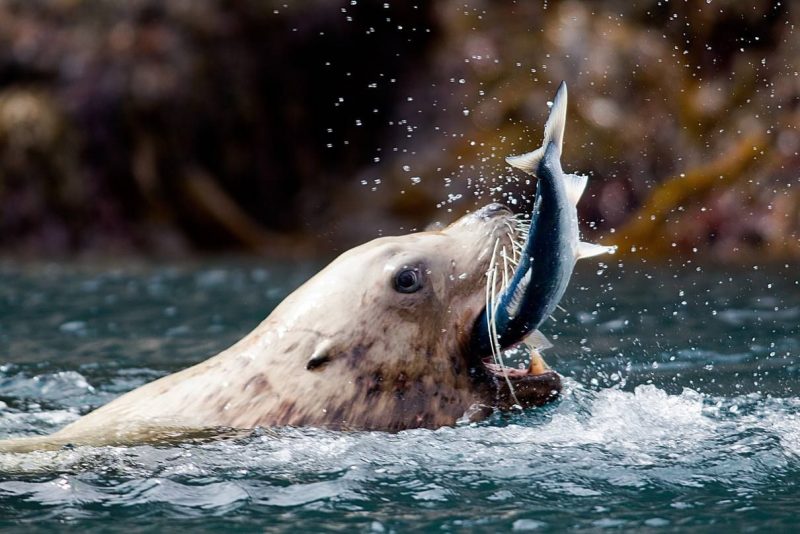“it’s now time to harvest or cull the seals and sea lions”
“The greatest road to extinction of salmon is all due to overpopulation of seals and sea lions” – Thomas Sewid of the Kwakwaka’wakw First Nation
By Fabian Dawson
SeaWestNews
Let us harvest and manage the population of seals in the Pacific Northwest.
That will be the central message carried by a group of First Nations elders to this week’s pinniped workshop in Bellingham, Washington.
The second seal & sea lion workshop addressing what needs to be done about the overpopulation is put on by Washington State Fish & Game and Canada’s Department of Fisheries & Oceans.
This workshop is part of the process addressing the call for a cull or harvest of seals and sea lions in Washington and British Columbia waters.
“Enough studies have been done…it’s now time to harvest or cull the seals and sea lions…if not we are certain to see the extinction of many salmon runs throughout the Pacific Northwest,” said Thomas Sewid, President of Pacific Balance Marine Management Inc. which is an all First Nations British Columbia group pushing for license to sell pinniped products.
“The greatest road to extinction of salmon is all due to overpopulation of seals and sea lions,” he said.
The United States announced earlier this year that it will allow the killing of up to 920 sea lions a year in the Pacific North West to protect endangered wild fish stocks.
The lethal removal program, for the first time, allows American native tribes to kill sea lions that are threatening endangered salmon and steelhead runs to extinction.
Since 1975, when the California sea lion population was estimated at 88,924 animals, their numbers have boomed, and it is estimated there are now approximately 257,631 animals, NOAA statistics show.
The hunting of seals and sea lions has been banned on Canada’s West Coast for more than 40 years. The harbour seal population in the Salish Sea is estimated at about 80,000 today, up from 8,600 in 1975.
Sewid’s group estimates that of the 27 million chinook smolts produced a year in the Salish Sea (wild and hatchery) the seals are consuming about 24 million of them.
A University of B.C.-led study published last year in the Canadian Journal of Fisheries and Aquatic Sciences also found that “changes in the numbers of seals since the 1970s were associated with a 74-per-cent decrease in the maximum sustainable yield in chinook stocks.”
“British Columbia has just experienced no commercial fisheries on many salmon stocks this spring, summer and fall, all due to disastrous returns,” said Sewid.
“B.C. First Nations are on the verge of losing boats and homes due to no commercial salmon revenue generation and many have no food fish to speak of for this winter.”
Sewid of the Kwakwaka’wakw First Nation, also took aim at eco-activists fighting proposals for a seal and sea lion harvest or cull in B.C. waters.
“The most destructive invasive species to be allowed to breed throughout Turtle Island a.k.a North America is the environmentalist. The Inuit can harvest on the most part unimpeded by environmentalists all due to their isolation. We cannot have that throughout the Pacific Northwest, but we can be left alone to harvest if Canada and the U.S. make or change laws regarding seals and sea lions.
“We Indians shall be at this workshop ensuring a voice of reason supporting a seal and sea lion cull or harvest is ensured,” he said.
Among those who will be attending the workshop will be Hereditary Chief Roy Jones Jr. of the Haida First Nation and Richard Harry C.E.O. of the Aboriginal Aquaculture Association.
Together under the Pacific Balance Marine Management Inc. they have identified numerous markets for all parts of seals and sea lions from furs, human food consumption, pet food consumption and medicinal needs from the Omega 3 fatty acids found in the oil.
This includes regional and International markets.
“Our organization anticipates over 4000 B.C. jobs from seal and sea lion harvests, if the Canadian Federal Department of Fisheries & Oceans allows a licensed harvest,” said Sewid.
Earlier, this month, Sewid, Chief Roy Jones Jr. and others met with a Chinese delegation to discuss potential partnerships and markets for a commercial seal hunt in B.C.
Canada exports furs worth about $100 million to China, including products from the legal East Coast seal hunt. The hunting and trapping industry in Canada is worth about $1 billion.
(Facebook Image)

